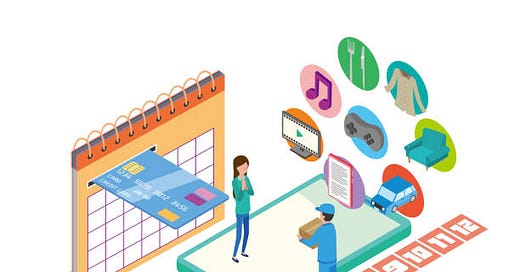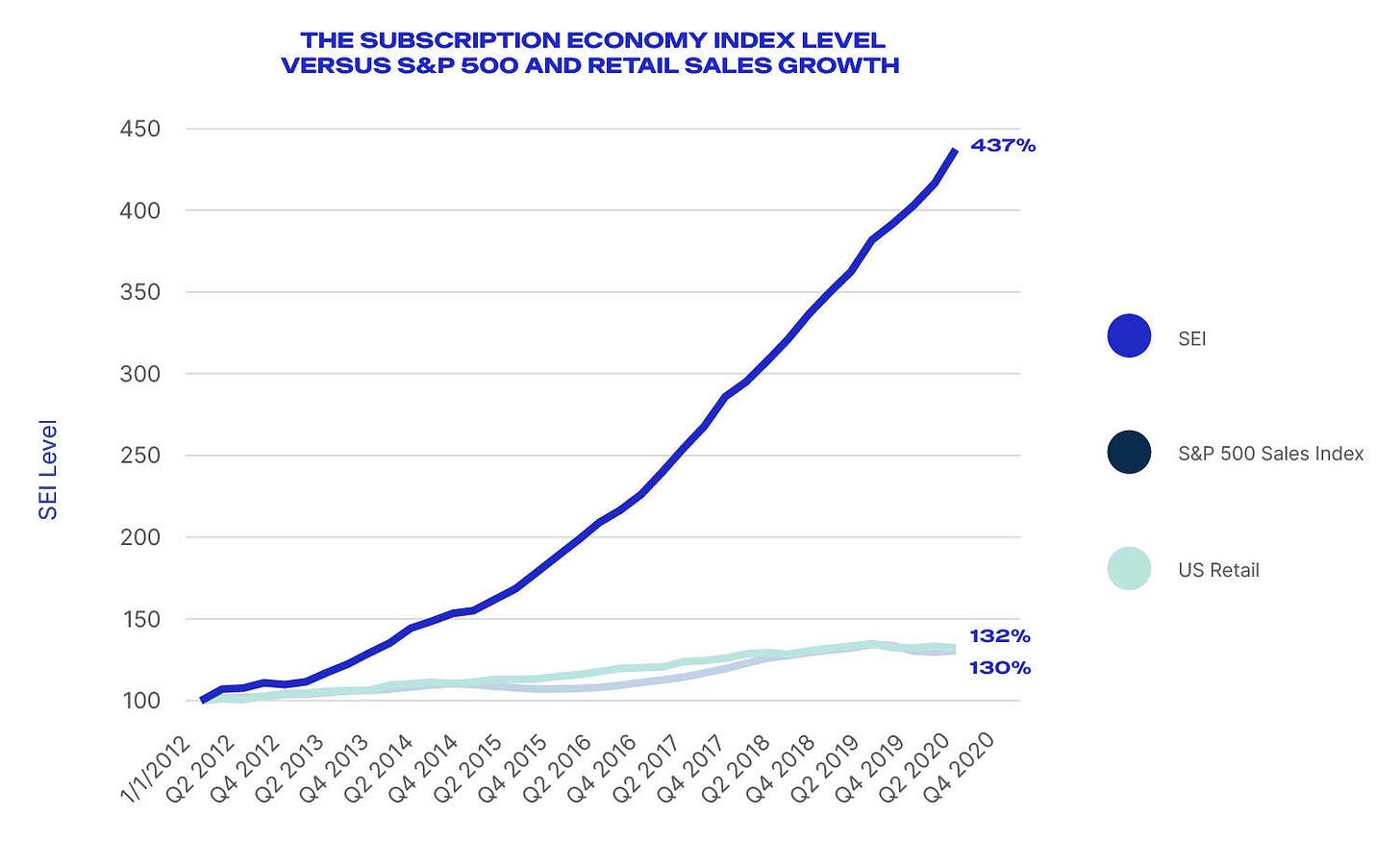Will you price this box, please? - Subscription based pricing
Subscription pricing model, subscription economy, CAC, CLV, customer retention, segmentation, value based pricing, Annual Recurring revenue, Ownership to access, usage based pricing
Dear Readers of Thinking category,
Few months back, I have posted about subscription programs by marketplace companies.
Then, we have discussed how to get the pricing right - concepts of supply and demand dynamics, value-based pricing.
And we talked about using CLV, customer retention rate as a tool to identify profitable customer segments for the business.
Today’s post is going to bring all of it together.
Subscription economy has been the talk of the business town. You can now subscribe to Netflix, Prime to satiate your entertainment needs. You can get Furniture on Rent (monthly subscription) from Furlenco, you can subscribe to Zoom car or you can replenish your milk bottles daily by subscribing to Country delight. All kind of subscription business exists.
image source - google image
The Subscription Economy® has grown nearly 6x (more than 435%) over the last 9 years according to Zuora Report (US market)1. A trend that is getting trickle down to other emerging economies as well.
A few days back, I was talking to a friend who was contemplating between buying furniture and renting furniture. In the total amount he pays for 12 months for the monthly subscription for furniture on rent, he can own the furniture instead. It doesn’t make sense from the financial calculation perspective.
Then there are stories like these:
Blue Apron’s CAC sat around $60 — less than the CAC of its main competitor, HelloFresh, which sat around the $80 mark. But even though it had an initial cost advantage over HelloFresh, Blue Apron struggled to hold onto its new customers, who were happy to take the free or discounted boxes that were so heavily promoted but often canceled after their first shipment. A staggering 75% of customers canceled their subscription within six months, meaning that Blue Apron failed to make a profit on them.
Still why so many subscription business models- Answer is Recurring payments. If you can keep your churn rate lower (Ideally ~5 %), you can get it going with lower CAC.
So, How to crack the subscription business?
My 2 cents:
Target a niche segment for the services which are otherwise difficult to procure and equally niche
Get your pricing right
So let’s start with a fictional business case.
You are running a subscription business for organic beauty products. Your target market is actor / actress / models / wealthy individuals / performance artists for whom looks are necessity. You sell only organic products with the promise of no chemicals, no skin irritation. It’s a premium product line. You have carefully curated the product from the supplier base that don’t sell in bulk /masses difficult to find them otherwise. It’s a monthly subscription and the package quantity is carefully designed to last only for a month based on the survey / research you have conducted with your target segment makeup artists etc.
Comment below what products or services could be sold under subscription based business model that are not currently being sold as a subscription to consumer. And why?
Now the question is how do you price it?
Your effort to find these products should be factored into it - You are reducing the search cost and making these products accessible for your niche segment who otherwise have to order from multiple sources for their beauty needs.
Note : This is a very basic model. So in case you are advanced marketer, it might not be interesting to you.
Pricing model :
(1) Calculate COGS & Fixed cost
(2) Add gross margin into it. You can roughly estimate the value of search cost that you are reducing for your customers. (The effort that has gone into finding the right suppliers, convenience cost for your target segment). You can place $ for each value differentiator / feature to calculate profit margin. For example - you can ask “how much will my target segment to get their hand on organic beauty products?” “If they have to themselves source from different suppliers, how much time it is going to cost to them?”
Sorry to interrupt you while you are reading so ardently If you like what you are reading, please subscribe to my newsletter. You will directly get these bi-weekly posts straight in your inbox.
You can also connect me at LinkedIn:
Let’s say you have rounded it to 10000 Rs. We are providing the premium service, hence we can go higher on our profit margin.
If some customers are dropping from the subscription service, you can always give some discounts (I wouldn’t suggest this in this particular case) to bring them back so have that cushion in your profit margin. Secondly, have your pricing right because later on if you want to increase your price, it would be difficult to convince your customers to pay higher who are accustomed to your previous pricing model.
(3) Let’s assume marketing cost here is = Customer acquisition cost (To keep it simple)
CLTV of the customer who stays with you for 12 months (8% churn rate):
= 3289 (Net profit for the first month)+ 4089 (Retained profit)*11 (for the next 11 months, you will be saving on customer acquisition cost. So 4089 (3289+1000) is your retained profit)
If you renting something, you can use PMT to calculate periodic payment / subscription fee. <Don’t divide annual cost by 12 to calculate monthly EMI, seen people doing that mistake>
As you scale, your CAC goes up. As you grow, CAC should stay stable to generate more value out of your business.
(4) Churn Rate Calculation
For above subscription database, churn rate of Jan month = 1/5 = 20% (Monthly churn rate)
Customer 1876 cancelled his subscription. And 1864, 1860,1859 - two new customers were added but for month Jan they will not be factored into the calculation.
Churn rate is important for subscription business. If Churn rate is higher, your investment into acquiring customer is the lost dollars.
If you run a subscription business and a customer has churned out from the business but after some gap - 6 months or so, she has again started your subscription services, Marketing efforts towards bringing her back to the business would be considered in CAC or retention budget? Would it be considered a fresh start for the customer - a new customer? IS this distinction important from data collection point of view? Leave a comment below.
Cohort analytics can help you to understand the behavioral characteristics of users who higher churn rate. For example - May be you find from your dataset that users with annual subscription stays longer with you compared to monthly subscription. Once you know the reason, you can design better churn rate reduction interventions like pricing strategies that makes annual subscription more lucrative for users.
In case you are interested in more complex models - cohort analytics, customer retention analytics, annual recurring revenue (ARR), ARPU, comment. This way I would know that you are really interested and It’s worth investing my time into writing about these.
Till then, Happy Weekend.
If you are looking for something funny and light to binge upon, watch Nathan for you for all the crazy/extreme marketing ideas/gimmicks.
https://www.zuora.com/resource/subscription-economy-index/








Thank you for this insightful article... would love to hear from you about the more complex models (cohort analytics/customer retention analytics/ARR). Also it would be an interesting read if you can share your opinion about market basket analysis & RFM.